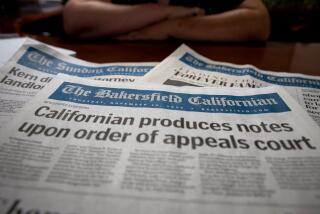Judge Lays Down the Law on Hedgecock Trial Seats
Protecting the public’s right to know can be a cutthroat business.
When the celebrated fraud and perjury trial of San Diego Mayor Roger Hedgecock began last spring, reporters from throughout the country sometimes battled among themselves and with the general public for courtroom seats. The latecomers wound up outside the door, biding their time. And woe be to the early birds who had to heed nature’s call.
“I didn’t know how much interest this case would generate.”
That’s what Judge William L. Todd Jr. acknowledged Tuesday when he met the press--not to take questions about the case, but to lay down his ground rules for coverage of the second Hedgecock trial. With jury selection scheduled to begin today, Todd explained that he wanted to avoid the problems that occurred the first time around.
Here’s the scoop: There are 36 seats in Todd’s courtroom, Department 24 of the Superior Court. Fifteen seats will be reserved for the press--including 12 seats earmarked for the members of the San Diego media who were given special passes in Tuesday’s meeting. A small number of seats also will be reserved for the Hedgecock family.
Otherwise, for both the general public and reporters without special passes, it’s first come, first served--or, as they say at rock concerts, “festival seating.”
It took about 45 minutes for the judge and the media representatives to work out the arrangement. For example, reporters from the San Diego Union and Tribune each asked for two passes. But Todd outlawed such greed. “I don’t think it’s fair to give any one entity more than one pass and I won’t do that,” he declared.
Another reporter asked how visiting reporters who lacked the special passes--be they from the New York Times or, say, the Back Country Trader--would be accommodated. They would simply have to get to the courtroom very early, Todd said. He also said that it was just too bad that some of the local papers, such as El Cajon’s Daily Californian, weren’t represented at the meeting. As one reporter put it, “If you’re not here, you’re screwed.”
Then there was the sticky question about what press credentials would be acceptable for the seats not specifically designated for the local radio, TV and print media. Todd decided that only press passes issued by the police (regardless of the jurisdiction) were valid. This ruling apparently was designed to foil the efforts of some court-watchers who brandished what many suspected were homemade press credentials to gain entry during the first trial.
Todd laid down some other laws for his courtroom, some of which struck some reporters as contradictory. He said he would allow newspaper reporters to use tape recorders only during the opening and closing arguments--even though TV cameras will be allowed to videotape the entire proceeding.
The media groused. Given the public interest in the case, shouldn’t the trial have been scheduled for Department 1, where there are about 100 seats, plenty for both the press and public? Or why not ask to borrow a federal courtroom with more space? Were Todd and Presiding Judge Donald W. Smith trying to reduce the prospect of a disorderly public spectacle by dictating the smaller courtroom?
“No, no, no,” Smith said later in a telephone interview. He said it would be “terribly awkward” to use his Department 1 courtroom because it is needed for the day-to-day duties of the presiding judge.
Smith said that he and Todd talked about the possibility of asking to use a federal courtroom or a mock courtroom at the University of San Diego law school, but they didn’t ask. Smith said he doubted that the federal courts had a vacancy, and said the USD facility is not well-suited for a jury trial.
“If I had a bigger courtroom available, I’d give it to you,” Smith said. He also said he would consider moving the Hedgecock case into Department 1 for the closing arguments, just as he did at the close of the first trial.
With such limited seating, Todd’s special passes are indeed special.
“I’m going to lock it up every night,” said Neal Putnam of the County News Service, whose office is in the courthouse pressroom. Otherwise, he said, some other reporter, or a sleuthing court watcher, might just come and swipe it.
More to Read
Inside the business of entertainment
The Wide Shot brings you news, analysis and insights on everything from streaming wars to production — and what it all means for the future.
You may occasionally receive promotional content from the Los Angeles Times.









